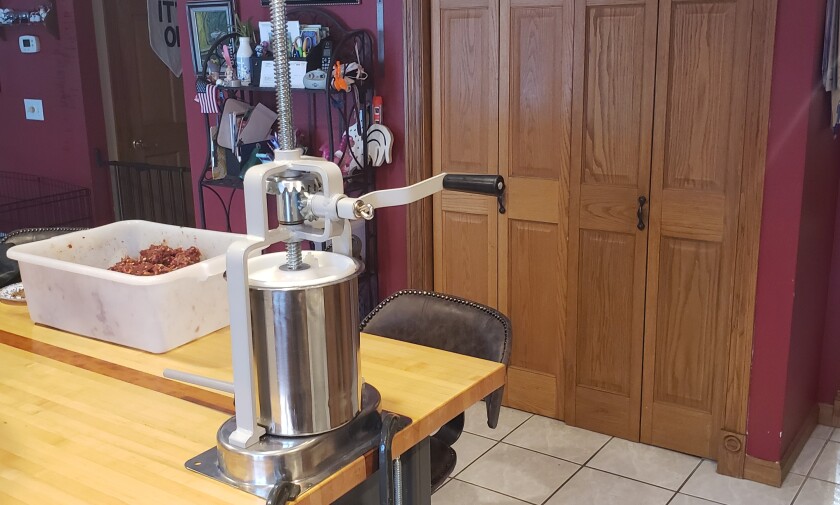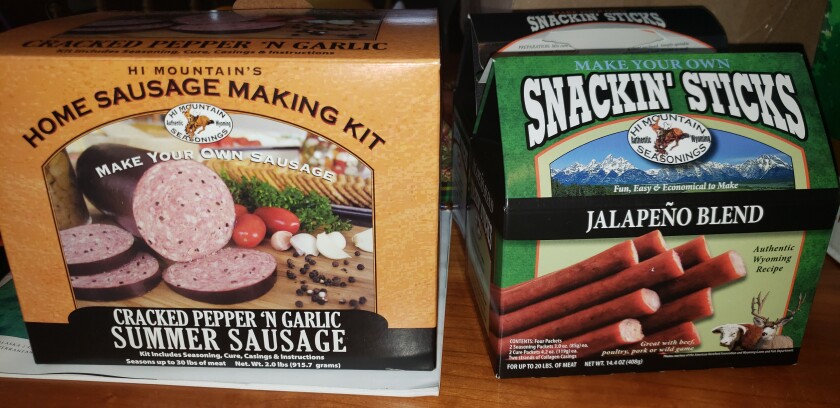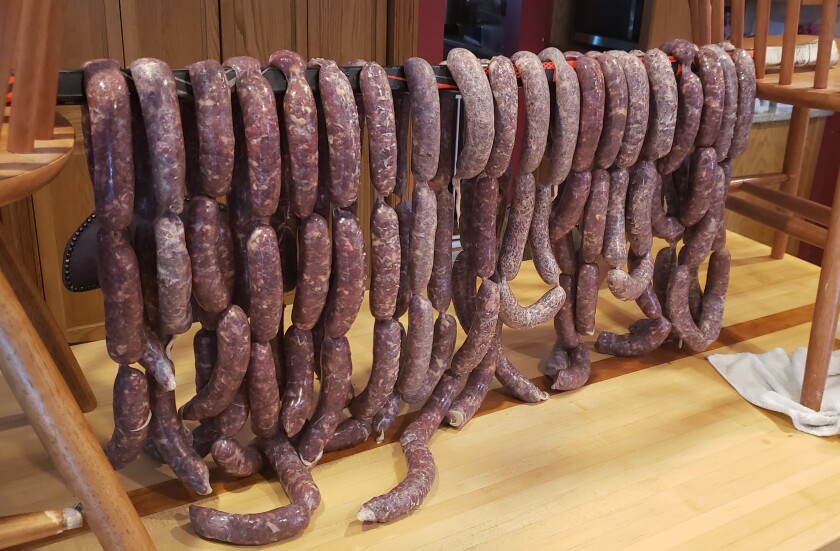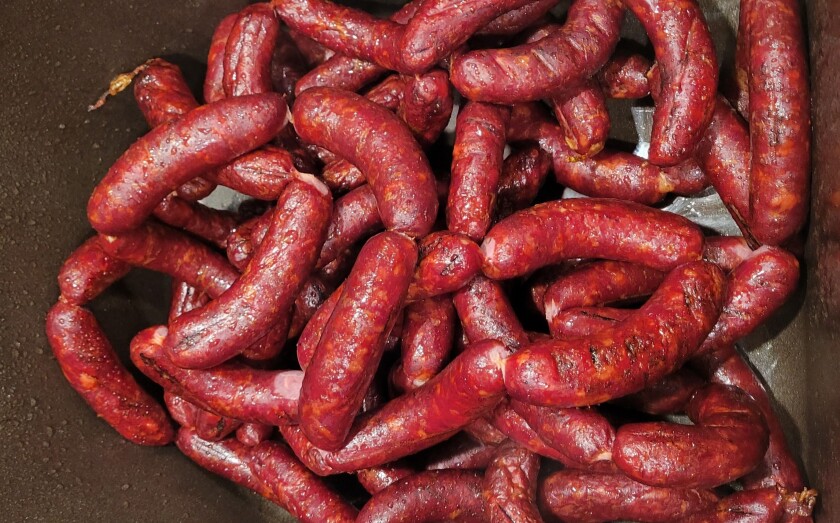GRAND FORKS — It’s a snowy December afternoon, and the kitchen of Jason Laumb’s Grand Forks home once again has been transformed into a portable meat processing shop, of sorts.
The task at hand: Make 50 pounds of venison sausage – 15 pounds of summer sausage, 10 pounds of snack sticks and 25 pounds of Polish sausage – over the next day and a half.
Deer season was especially successful this past fall for Laumb, director of Advanced Energy System Initiatives at the University of North Dakota Energy and Environmental Research Center in Grand Forks. He filled both of his Minnesota deer tags, along with a doe tag in western North Dakota and a hard-to-draw North Dakota muzzleloader buck tag he filled less than an hour into the opening day of the black-powder season on Friday, Nov. 26.
Sausage is a favorite way of getting that bounty from field to fork, and I was there to help.
We’ve done this numerous times over the years, grinding and mixing and stuffing and smoking and – of course – sampling the final product to make sure it’s up to snuff.
ADVERTISEMENT
It always is, and this year would be no exception.
Growing up in Berthold, North Dakota, Laumb, 46, says sausage-making has been a family tradition since he was 10 years old. Plus, it’s a most enjoyable way to spend a snowy winter weekend.
With that DIY experience as a backdrop, Laumb says making his own sausage is a lot cheaper than bringing it to a processor – especially after seasons when he shoots four deer.
“That, in a lot of cases, would be a $1,000 processing bill,” he told me in a 2012 Grand Forks Herald story. “You can buy a lot of processing equipment for $1,000.”
Laumb received a high-speed grinder as a gift several years ago and more recently bought his own stuffer, a slick, stainless-steel unit that cleans up a lot easier than the old cast iron stuffer he used to borrow from his grandparents.

Brad Dokken / Grand Forks Herald
Laumb used kits from Hi Mountain Seasonings for this year’s sausage recipes. In addition to the Polish sausage kit, he used Jalapeno Blend for the snack sticks and Cracked Pepper ‘N Garlic for the summer sausage.
The kits include all of the curing salt, seasonings and casings; collagen casings for the summer sausage and snack sticks and natural hog intestine casings for the Polish.

Brad Dokken / Grand Forks Herald
From there, it was simply a matter of mixing the right amount of ground meat with the cures and seasonings. Laumb added a mixture of 10% suet, purchased at a local meat shop, to the summer sausage.
ADVERTISEMENT
In addition, pork will comprise one-fourth to one-third of the meat in a typical sausage recipe, Laumb says. He also added high-temperature pepper jack cheese to the summer sausage and high-temp cheddar to the jalapeno sticks.
Laumb approaches the sausage-making process with the meticulous touch of an engineer. A digital scale is crucial to ensure a proper mixture of meat, curing salt and spices, he says.
“You can’t guess, on the amount of meat you’re putting in,” he said.
Laumb in recent years has added a new twist to his sausage recipes by grinding up three or four white onions and mixing them with the meat and spices. A friend of Polish descent who is well-versed in the art of making sausage suggested giving it a try, Laumb says, and it’s been a keeper ever since.
Besides adding flavor and a tish of added zing, the onions add moisture.
Once the ingredients are mixed, it’s time to stuff. I turned the crank on the stuffer, while Laumb managed the casings.
Smoking completes the process for most of Laumb’s recipes, and he keeps the smoker at a temperature of no more than 165 degrees and smokes the sausage until it reaches an internal temperature of 150 to 155 degrees. That can take up to 6 hours, although Laumb moves the summer sausage to the oven after a couple of hours, cooking it at a low temperature to finish cooking.
Before adding the Polish to the smoker, Laumb puts it on a makeshift rack – in this case a hockey stick set between two chairs – to dry for an hour or two. The sausage absorbs the smoke a lot better when the casings are dry, he says.
ADVERTISEMENT

Brad Dokken / Grand Forks Herald
Over the years, Laumb has used a variety of different meats in his sausage recipes in addition to venison, including geese and sandhill cranes. In 2019, we made moose sausage in Laumb’s kitchen after I filled my once-in-a-lifetime North Dakota cow moose tag.
In 2020, Laumb filled his once-in-a-lifetime cow elk tag on the last day of season, and so elk was a key ingredient in last winter’s sausage-making process.
Last winter’s sausage-making venture wasn’t the social occasion it normally is, though, because COVID-19 vaccines weren’t yet widely available and getting together as we normally do didn’t feel safe.
Different story this year, though. Getting back into the kitchen to help make sausage was not only fun – it also was tasty.

Brad Dokken / Grand Forks Herald
"tasty" - Google News
January 08, 2022 at 07:38AM
https://ift.tt/3q69KvP
Making venison sausage marks tasty finale to successful deer season - Grand Forks Herald
"tasty" - Google News
https://ift.tt/2VXquX3
https://ift.tt/3c08sJp
Bagikan Berita Ini














0 Response to "Making venison sausage marks tasty finale to successful deer season - Grand Forks Herald"
Post a Comment